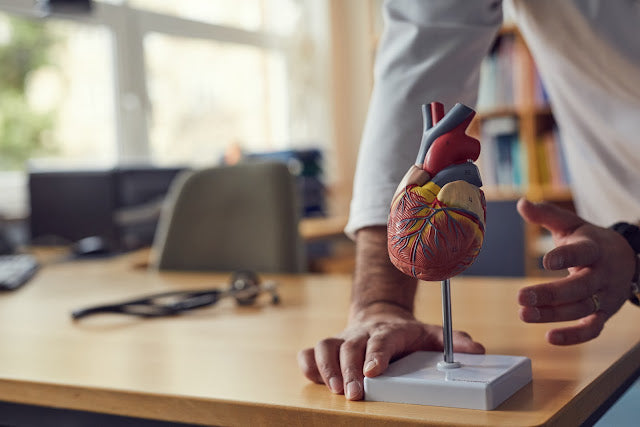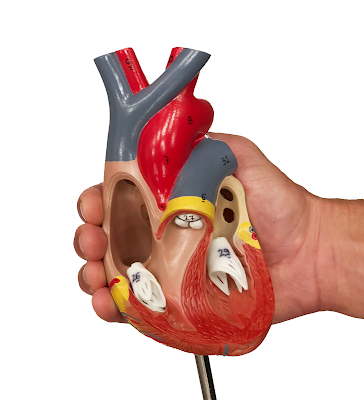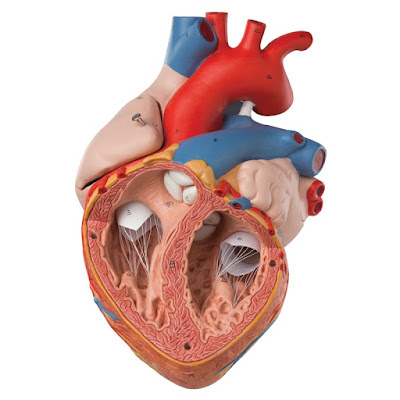
The heart model's place in teaching & explanation
Dela med sig
"So, now you have to listen. Atherosclerosis and blood clots due to atherosclerosis do not occur in the chambers of the heart, but in the blood vessels that supply the heart muscle itself with blood. Can you follow me – or should I try to draw it”?
Teachers, professionals and other mediators can easily be challenged when they have to explain the anatomy and diseases of the heart.
A heart model when learning anatomy
The anatomy of the heart is complex and is best understood in 3 dimensions. A heart model is better than a picture to illustrate the 3 dimensions. Most people know that the heart acts as a pump, where the blood flows through the heart. If you also need to understand that the heart actually consists of 2 pumps that drive the blood through a pulmonary circuit and a systemic circuit, everything else will be easier to understand with a heart model at hand.
A heart model can also increase the understanding of other anatomical structures, such as the heart's own blood supply via the coronary arteries, which penetrate into the heart muscle, and the heart's valves, which consist of 2 very different valve systems.
A "real" heart from, for example, a pig or a human is soft tissue that quickly changes shape when touched. Most blood vessels are also confusingly similar. A heart model, on the other hand, is made of hard material, which is why anatomical structures such as blood vessels to and from the heart are easier to keep track of. The blood vessels (arteries and veins) are also illustrated in red and blue color on the heart model, which is a great advantage in learning.
A heart model when understanding heart disease
Unfortunately, many people are affected by heart disease, and "widespread heart diseases" include, among other things, atherosclerosis and blood clots, atrial fibrillation (atrial fibrillation) and valve diseases such as aortic stenosis and mitral insufficiency. If you also want to understand disease processes in the heart, it may be even more important to have a heart model at hand.
Atherosclerosis and blood clots in the coronary arteries are 2 different disease processes that can result in reduced blood supply to the heart muscle (called ischemia). Some patients are treated medically - others with balloon dilation of the coronary arteries or bypass surgery. Describing all this educationally for a patient, a student or others requires close-up images of the anatomical structures in 3 dimensions, where a heart model can again be far better than images.
Understanding can possibly be increased if the recipient is also given the opportunity to feel the structures with their fingers - for example, feel and follow the departure of the coronary arteries from the aorta or squeeze the heart muscle (wall) when the heart model is open.


Hand painted heart model - ENLARGED. Seen here opened.
If you want to understand/explain atrial fibrillation and other conduction disorders such as atrial flutter, AV block and bundle branch block, a heart model with the impulse conduction system can be extremely beneficial. It can make it easier to explain the course of the current and the consequences of the disturbances. The same applies to valvular heart disease, where a suitable heart model should be chosen carefully.
Some heart models illustrate the attachments of the AV valves to the papillary muscles too simplistically, which is not ideal if, for example, mitral insufficiency is the focal point.
In our category " The heart and the vascular system " on eAnatomi.dk, you can choose between heart models that are reduced, in natural size or enlarged. There are also models with the impulse conduction system, models with the result after bypass surgery, models with a focus on the heart valves and models with surrounding organs (e.g. esophagus and trachea). We also have special hearts in the form of a fetal heart and a heart with hypertrophy of the left ventricle. Over many years, we have expanded the range in the hope of being able to cover everyone's needs. You can explore our large, versatile and exciting range at eAnatomi.dk.
